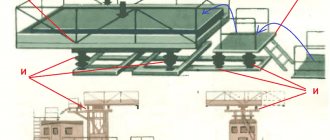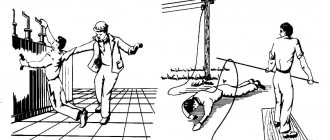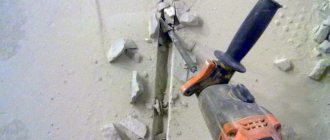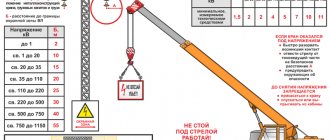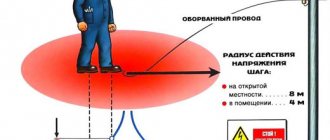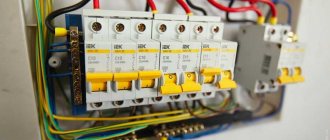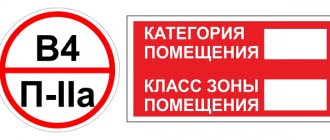Safety precautions for persons who are allowed to work with the tool
The operator - the one for whom all safety measures are undertaken - is subject to appropriate requirements regarding his training, protective equipment and, in fact, rules of conduct during work.
Operator qualification requirements
An employee is allowed to act as an operator:
- at least 18 years of age;
- knowledgeable about the rules for using this equipment;
- having an electrical safety group no lower than class II;
- completed the latest occupational health (occupational health) and safety (safety) training no earlier than 3 months ago;
- able to provide first aid, including self-help;
- passed a medical examination;
- completed an internship.
If we are talking about a specialist who only maintains the tool in working condition, regularly inspecting and testing it, then the electrical safety group of such a worker should not be lower than class III.
Operator equipment requirements
Minimum set of personal protective equipment:
- comfortable workwear made of cotton fabrics - one that does not hinder movement and does not have hanging ends, belts, or protruding pockets that could get into the moving parts of the tool;
- safety glasses or mask;
- head protection if you have long hair (scarf, hairpin);
- Stable shoes with non-slip soles.
Protective measures that are used when certain conditions are met:
- vibration-isolating gloves/anti-noise helmets or headphones – if the vibration/noise level exceeds the norm;
- gloves and shoes based on dielectric materials - if any work is carried out with tools of class I. For classes, see the corresponding chapter.
All protective equipment must have an inspection stamp and a note indicating the date of the next inspection.
Labor protection requirements before starting work
2.1. Wear the required protective clothing and safety shoes, prepare serviceable and tested personal protective equipment (insulating gloves, galoshes). Do not allow parts of clothing to hang loosely and tuck them in, fasten the cuffs of the sleeves, being careful not to catch them in the rotating parts of the power tool.
2.2. Before the beginning:
— check the lighting of the workplace;
- inspect the workplace, put it in order: remove foreign objects, clear the approaches to it, clean them of debris and remnants of building materials, eliminate the presence of moisture and oil on the floor.
2.3. Before handing over the power tool, check:
— completeness, serviceability, including cable, plug and switch, reliability of fastening of power tool parts;
— serviceability of the grounding circuit of the power tool and absence of short circuit of the windings to the housing;
— operation of the power tool at idle speed.
A power tool that is faulty or has expired its periodic inspection date must not be issued for use.
2.4. Before starting work, check:
— the class of the power tool, the possibility of its use from a safety point of view in accordance with the place and nature of the work;
— compliance of the voltage and frequency of current in the electrical network with the voltage and frequency of current of the electric motor of the power tool;
— operability of the residual current device (depending on operating conditions);
— reliability of fastening of the removable tool.
2.5. For class I power tools, additionally check the serviceability of the grounding circuit (between the machine body and the grounding contact of the plug).
2.6. Working tools, devices and auxiliary materials should be arranged in an order convenient for use and their serviceability should be checked.
2.7. Report any shortcomings noticed in the workplace to the work manager and do not begin work until he receives his instructions.
General instructions on safe work
- Before turning on the tool, the operator must ensure that it is in a stable position. If he works in the so-called comfortable zone (see chapter “Preparing and checking the room ...”), the device should be in front of the body, at a height just above the elbow.
- When working with other operators, you should work in your own area, and actions must be coordinated.
- Installation and removal of attachments and other replaceable parts can only be done when the device is unplugged. Any manipulation of parts of a working device is prohibited.
- The device may only be turned on when it is in the operating position.
- It is prohibited to transfer control of the device to other unqualified operators.
- Drilling, sawing and cutting is prohibited in hidden areas where utility lines may be laid.
- It is prohibited to disassemble, let alone carry out minor repairs to, the equipment without disconnecting the power supply.
- It is prohibited to remove cuttings or shavings from under the moving parts of the power tool until they have completely stopped and the device has been turned off from the power supply.
- Until the moving parts come to a complete stop, do not touch them with your hands or any objects.
- You should position yourself so that if the electrical appliance fails, you will not be in the path of flying parts. This applies to cutting, sawing and drilling tools.
- An operator who is under the influence of any intoxicating (including narcotic) substances is prohibited from operating a power tool.
Instructions on safe work with specific categories of tools
Angle grinder or UOM
- Checking the idle speed for half a minute is a mandatory condition that must be observed before work.
- Ventilation holes and other parts must be cleaned after completion of work. Conductive dust that settles on parts of the device must be removed regularly, otherwise it will damage the protective insulation.
- This tool is used exclusively for cutting and grinding.
- Sparks must not fall on the operator, people around him or the cable.
- When working with the machine, the power cable is routed behind its body.
- A protective guard must be used with the rough grinding wheel, with the closed side facing the operator. When working with this tool, it is mandatory to comply with the prescribed dimensions of the grinding wheels.
Drilling machines
- When moving parts become jammed and unravel, a reversal occurs; For this purpose, special stops are provided that will prevent injury.
- Drilling into walls and partitions in which electrical cables may be laid should only be done when they are disconnected from the power supply.
- Unplug the device from the outlet while the drill is still in the drilled hole.
What is prohibited when working with power tools
The main prohibitions when working with power tools are dictated by the preservation of human life and health.
What is prohibited when working with power tools
Forbidden:
- use when there is a burning smell, sparks, smoke or flame, noise and knocking at an increased level;
- work with the tool longer than the instructions indicate;
- give it into the hands or work of a person who does not have the right to do so (age, health status);
- touch the working part, especially the working (rotating) one;
- touch the power cable of the tool or step on it;
- cross the power supply with other cables and hoses;
- cool from overheating with water or snow;
- work on a ladder or an unstable surface;
- remove sawdust and shavings from under the working tool with bare hands;
- handle wet and frozen parts.
Safety is below acceptable levels in unventilated and explosive areas.
Classes of power tools and specialized fuses for working with them
You can find out the safety class of each power tool by the markings on the body, usually on the main part of the machine.
Now let’s talk about how the safety of machines of each class is ensured and where they can be operated.
| Class | Basic safety devices | Premises where operation is permitted |
| 0 | Working insulation | Products are used only when built into earthed housings |
| I | Working insulation and grounding of accessible conductive parts | Premises without increased danger |
| II | Double or reinforced working insulation without protective conductor/grounding contact | Premises with increased danger and in open space |
| III | Extra Low Voltage Power Supply | Premises with unfavorable conditions (closed hangars, wells, mines) and a high hazard class |
To safely work with power tools, use devices such as:
- isolation transformers;
- residual current devices;
- generators operating autonomously;
- mechanical protection devices (for example, protective covers).
How are power tools classified?
Electrical equipment is a tool that receives power from the network: drill, plane, saw, grinder, grinder and others. Power can be supplied from a battery. It can also be called mobile - if there is mobility (mini power plant).
For safety reasons, classification is carried out according to the need for grounding.
Classification of power tools
General labor protection requirements when working with power tools characterize them as follows:
- “0” class has insulation to a standard extent; the environment or another object will react to the breakdown;
- “1” class requires insulation of external metal parts from current leads;
- “2” class, all metal parts are separated from the current supply, insulation is up to several layers;
- “3” class has the most powerful protection against electric shock, the housing is made of dielectric, voltage is up to 42 V.
To put it simply: it is divided into two types – manual (mobile) and stationary. The first does not require grounding with a separate wire, the second does.
They are also divided according to the availability of protection: individual, collective means of protection. Residual current devices can be located in a redundant design. The main protection of the worker is provided by the grounding wire.
The parameters of frequency of use and periodic maintenance do not play a role in the classification. All mechanisms must withstand repairs.
The main regulatory documents are PTEEP and regulatory documents on TB (safety precautions). There are practically no new rules for working with power tools. The main rule: you should start working with a power tool if you have confidence in every movement.
Preventative measures before starting work
Before starting work (for example, at the beginning of a shift), it is necessary to inspect the workplace and tools.
Preparing and checking the premises and workplace
Make sure that the operating voltage of the tool you plan to use matches the class of the room.
- Equipment with a voltage of no more than 220 V can be used in class I premises.
- Equipment with a voltage of 42 V is intended for class II premises; in exceptional cases it is possible to increase the voltage to 220 V, but only with the use of protective insulating equipment by the operator. In such premises, lighting devices with a voltage of no more than 12 V are allowed, and autotransformers cannot be used as a source - only transformers and batteries. The plugs of the devices are structurally different from those designed for 220 V in order to prevent their connection to a high voltage source.
The workplace itself should also be checked for compliance with general safety requirements.
- The approach to power supply panels and fire hydrants should not be obstructed - in the event of an accident, if one occurs, this will make access to them difficult.
- When using power tools, you are only allowed to be on scaffolding: working on ladders is prohibited by safety regulations.
- If the operator operates a power tool in a closed container, the power source for the latter must be located outside the container. In this case, the secondary circuit is not grounded.
- All areas of the surface being processed are well illuminated; first of all, this requirement is met when working with cutting, sawing and drilling devices.
- The optimal distance from the operator to the surface being processed is about 50 cm - this condition must be taken into account when installing scaffolding and stepladders.
- When working with hand-held power tools weighing over 10 kg, it is possible to hang the device.
- There is a concept of convenient and inconvenient zones for work: this zoning is taken into account when organizing the workplace. For an operator with an average height of 175 cm, these are the following indicators: 1) inconvenient zone - at a height of up to 40 cm from the floor; 2) middle zone - at a height of up to 100 cm from the floor; 3) comfortable zone – at a height of up to 165 cm from the floor (eye level); 4) inconvenient zone from 165 cm from the floor and above. If it is possible to optimize the space for a convenient area, you need to do this.
- The floor or surface of the scaffolding must be smooth and non-slip. There should be no foreign objects on them.
- The treated surface is firmly fixed.
- No weights are placed on the cables, and the cables cannot intersect with hoses of gas welding equipment or come into contact with heated surfaces.
- When working outdoors, only extension cords of those categories that are intended for open-air use are allowed.
Checking power tools
The power tool must meet the following requirements:
- the stranded wires of the device are enclosed in a rubber hose;
- Metal device cases are grounded if the supply voltage exceeds 42 V.
Whenever checking a tool (before starting work, for example, before a work shift), you should pay attention to:
- availability of all components and reliable fastening of removable/replaceable parts;
- serviceability of the start button/switch (can be checked at idle);
- the presence of protective covers prescribed by the instructions, if they are provided (in this case, for abrasive wheels with a diameter of more than 40 mm, covers are required. Material - sheet steel, opening angle - no more than 90⁰);
- serviceability of the gearbox;
- inaccessibility of conductive parts for accidental contact;
- compliance of the mains voltage with the rated voltage of the power tool motor;
- for class I instruments – the grounding circuit and its serviceability;
- compliance of the cutting parts (drills, sawing and abrasive discs) with a tool of this particular type.
It is prohibited to use the device if:
- there are serious visible defects (chips, cracks) on the case and any other parts of the device;
- the cable or plug is damaged;
- the cable and/or plug come into contact with wet surfaces;
- the cable is strained, twisted or there is a possibility of chafing;
- the device has not passed inspection and testing within the period specified by GOST;
- the start button/switch does not work properly;
- grease leaks from the ventilation ducts or gearbox;
- vibration or noise from the tool exceeds the norm.
Power tools should be checked every month using a megohmmeter (megger) to ensure there are no open ground wires or shorts to the frame. During this inspection, the insulation is also inspected.
Megohmmeter for measuring resistance
New-electro
The power tool must meet the following basic requirements:
a) quickly turn on and off from the power supply (but not spontaneously);
b) be safe to operate and have live parts inaccessible to accidental contact.
Portable and mobile electrical receivers and auxiliary equipment for them must be subject to periodic inspection at least once every 6 months.
The scope of periodic inspection of portable mobile power receivers and auxiliary equipment includes:
- visual inspection
- Check idle speed for 5 minutes
- insulation resistance measurement
- checking the serviceability of the grounding circuit of electrical receivers and auxiliary equipment of classes 1*
Before working with hand-held electrical machines, portable power tools and lamps, you should:
- check the inspection date;
- determine the class of a machine or tool from the passport;
- check the completeness and reliability of fastening of parts;
- make sure by external inspection that the cable (cord), its insulating tube and plug are in good condition, the integrity of the insulating parts of the case, the handle and brush holder covers, and protective covers;
- serviceability of the gearbox by turning the power tool spindle by hand (with the electric motor turned off);
- check the operation of the switch;
- perform (if necessary) testing of the residual current device (RCD);
- check the operation of the power tool or machine at idle speed;
- Check the serviceability of the grounding circuit of a class 1 machine* (machine body, grounding contact of the plug), etc.
* Class 0 should include electrical receivers that have working insulation, do not have elements for grounding and are not classified as class II or III
* Class
I should include electrical receivers that have working insulation and an element for grounding. The wire for connection to the power source must have a grounding conductor and a plug with a grounding contact. The designation at the grounding contact is PE or white-green stripes or the word “earth” in a circle *
* Class
II should include products that have double or reinforced insulation and do not have elements for grounding. Designation - double square *
* Class
III should include electrical receivers for operation at safe extra-low voltage, which have neither external nor internal electrical circuits operating at a different voltage. Designation - rhombus with III *
Ultra-low (small) voltage
- not exceeding 50 V AC or 120 V DC.
When working with class I, the following are used: gloves, boots, galoshes, mats.
When connecting a class I instrument through an RCD, electrical protective equipment does not need to be used.
It is not allowed to use hand-held electrical machines, portable power tools and lamps with related auxiliary equipment that are defective or have not undergone periodic inspection or testing.
When using power tools, hand-held electrical machines, portable lamps, their wires and cables should be suspended whenever possible.
Direct contact of wires and cables with hot, wet or oily surfaces or objects is not allowed.
The power tool cable must be protected from accidental mechanical damage and contact with hot, damp and oily surfaces.
It is not allowed to pull, twist or bend the cable, place a load on it, or allow it to intersect with cables, cables, or gas welding hoses.
If any malfunctions are detected, work with hand-held electrical machines, portable power tools and lamps must be stopped immediately.
The voltage of the power tool must be:
1. no higher than 220V in rooms without increased danger;
2. not higher than 36V in high-risk areas and outdoors.
If it is impossible to ensure the operation of a power tool at a voltage of 36V, it is permissible to use a power tool with a voltage of 220V if there is a residual current device or reliable grounding of the power tool body with the mandatory use of protective equipment (dielectric gloves, galoshes, rugs)
In particularly hazardous areas and in the presence of unfavorable conditions (in boilers, tanks, etc.), it is allowed to work with power tools at a voltage not exceeding 36V with the mandatory use of protective equipment (dielectric gloves, mats, etc.)
Work with the use of a portable or mobile electrical receiver that requires personnel to have electrical safety groups is allowed to employees who have undergone occupational safety training and have an electrical safety group.
Connection (disconnection) to (from) the electrical network of portable and mobile power receivers using plug-in connectors or plug connections that meet electrical safety requirements is permitted to be performed by personnel authorized to work with them.
Connecting portable, mobile electrical receivers and auxiliary equipment to them to the electrical network using dismountable contact connections and disconnecting it from the network must be carried out by electrical personnel with group III operating this electrical network.
In the event of a power failure or interruption in operation, power tools and hand-held electrical machines must be disconnected from the electrical network.
Workers using power tools and hand-held electrical machines are not allowed to:
- transfer manual electric machines and power tools, at least for a short time, to other employees;
- disassemble hand-held electrical machines and power tools, make any repairs;
- hold on to the wire of an electric machine, power tool, touch rotating parts or remove shavings and sawdust until the tool or machine comes to a complete stop;
- install the working part into the chuck of a tool, machine and remove it from the chuck, as well as adjust the tool without disconnecting it from the mains with a plug;
- work from ladders: to perform work at height, strong scaffolding or scaffolding must be installed:
- Etc.
Release from electric current.
Touching live parts that are energized in most cases causes involuntary convulsive muscle contractions. As a result, the fingers, if the victim holds the wire with his hands, can compress so much that it becomes impossible to release the wire from his hands. Therefore, the first action of the person providing assistance should be to quickly turn off the part of the installation that the victim is touching.
The following must be taken into account:
- if the victim is at a height, turning off the installation and freeing the victim from the electric current can lead to the victim falling from a height: in this case, measures must be taken to ensure the safety of the victim’s fall.
- when the installation is turned off, the electric lighting may also turn off at the same time, and therefore it is necessary to provide lighting from another source (lantern, etc.)
If the installation cannot be switched off quickly enough, measures must be taken to separate the victim from live parts that he touches.
To separate the victim from live parts or wires, use dry clothing, a rope, a stick, a board or any other dry object that does not conduct electric current.
After releasing the victim from the electric current:
- report this situation to your immediate supervisor
- call the necessary help
- take measures to provide pre-medical care
Conditions for using power tools
and hand-held electrical machines of various classes
| Work location | Class of power tools and hand-held electrical machines according to the type of protection against electric shock | Conditions for using electrical protective equipment |
| Premises without increased danger | 0 | Using at least one electrical protective agent |
| I | With the TN-S system - without the use of electrical protective equipment when connected through a residual current device or with the use of at least one electrical protective device. With the TN-C system - using at least one electrical protective device | |
| II | Without the use of electrical protective equipment | |
| III | Without the use of electrical protective equipment | |
| Premises with increased danger | 0 | With the TN-S system - using at least one electrical protective device and when connected through a residual current device or when connected through a residual current device or when only one electrical receiver (machine, tool) is powered from a separate source (isolating transformer, generator, converter). With the TN-C system - using at least one electrical protective device and when only one power receiver is powered from a separate source |
| I | With the TN-S system - without the use of electrical protective equipment when connected through a residual current device or when only one electrical receiver (machine, tool) is powered from a separate source (isolating transformer, generator, converter). With the TN-C system - using at least one electrical protective device | |
| II | Without the use of electrical protective equipment | |
| III | Without the use of electrical protective equipment | |
| Particularly dangerous premises | 0 | Not allowed to be used |
| I | With protection by a residual current device or using at least one electrical protective device | |
| II | Without the use of electrical protective equipment | |
| III | Without the use of electrical protective equipment | |
| In the presence of particularly unfavorable conditions (in vessels, apparatus and other metal containers with limited ability to move and exit) | 0 | Not allowed to be used |
| I | Not allowed to be used | |
| II | With the use of at least one electrical protective equipment Without the use of electrical protective equipment when connected through a residual current device or when only one electrical receiver is powered from a separate source | |
| III | Without the use of electrical protective equipment |
Related materials:
- Guidelines for testing protective equipment. General rules for testing protective equipment
Safety measures in case of emergencies
Failure of a power tool
Signs of device failure:
- cable damage;
- sparking and, moreover, the appearance of flame;
- appearance of smoke;
- the appearance of a burning smell, burning rubber or insulation;
- an increase in noise level or the appearance of uncharacteristic noises or knocking;
- an increase in vibration level or the appearance of uncharacteristic vibration.
After disconnecting the device from the network, it is checked and, if necessary, replaced with a working one.
Fire occurrence
- Operation of all instruments in the room connected to the electrical network stops.
- The room is completely de-energized using a switch.
- Extinguishing live electrical wiring (if it is not possible to de-energize it) can only be done with powder and carbon dioxide fire extinguishers.
Operator accident
- In the event of an electrical shock, the operator should be removed from the source of current, ideally by turning off the power. If this is not possible, take him away from the victim with any object that is not a conductor.
- In case of arterial bleeding, a tourniquet is applied; in case of electrical burns, the damaged area of the skin is cooled (if the burn blisters are not damaged, you can place the part of the body under a stream of cold water and then bandage it; if damaged, bandage it and apply a cold object: in this case, rinsing the skin is prohibited).
- If there is no pulse, an indirect cardiac massage is performed.
Hazards when using manual EI
Safety precautions when handling electric current
The active use of hand-held machines is accompanied by a number of specific factors that directly or indirectly affect the safety of working conditions. The following circumstances are considered the most dangerous factors when working with hand-held power tools:
- The remoteness of the nearest electrical point for connecting the EI to the electrical network at industrial or construction sites requires the use of multi-meter electrical extension cords, which during the course of work may lose the integrity of the protective shell and end up in a wet or oily environment;
- The presence of moving equipment and moving metal objects (products, workpieces, materials) with sharp edges or burrs that can damage or break the EI cable and cause an electric current short circuit;
- Operating EI in open areas in rain or snow, processing wet materials or wet surfaces;
Important! A humid environment is conductive, which poses a serious hazard, especially when using electrically conductive extension cords assembled from several pieces of cable with exposed twists.
- Unnatural body positions when working with manual EI, working on ladders, lack of stable support when working at heights - all this is fraught with loss of balance and falling from a height;
- Working with a faulty tool or using an EI with an overload of its power capabilities.
Note! Quite often, EI users purchase a cheap counterfeit tool for occasional use, motivating their pseudo-savings by the fact that even in the case of one-time use, the unit will already pay for itself. With intensive use of a low-quality mechanism beyond its power characteristics, the working parts are destroyed (drills break, cutting discs crack, etc.) and the EI breaks down, up to the point where its electric drive ignites.
In Fig. Below is a counterfeit screwdriver that was destroyed by the applied torque when tightening screws with a diameter of 6 mm.
Collapsed screwdriver
Basic operating rules
Improper use of a power tool can result in tragedy for the user: everyone knows that there is no safe voltage. Under certain environmental conditions, even a small electrical discharge can cause irreparable damage to the human body. It is necessary to follow safety rules when using power tools, which are divided into 3 stages:
- activities before work;
- during the operation of the instrument;
- after work.
Personal protective equipment when working with power tools
There are a number of basic conditions that should not be neglected at any stage of contact with power tools:
Hand protection when working with power tools
- Basic safety check of the tool, including inspection of live parts and possible damage.
- Familiarization with the requirements included in the document from the device manufacturer.
- Checking the grounding level of power tools that operate at voltages above 42 V.
- Checking the insulation of wires with a plug and protective tube.
- The use of devices with a voltage of no more than 42 V under favorable operating conditions, 12 V under unfavorable operating conditions.
- Permission to work with power tools during precipitation only in dielectric gloves in the presence of protective canopies.
- Storage of items in a separate dry room, registration of all pieces of equipment in a separate document.
Carrying out the workflow
Safety precautions when working with power tools also imply compliance with the age criterion, allowing the following employees to work:
Working with power tools
- Persons over 18 years of age who are familiar with TB and regulatory rules for the use of electrical appliances.
- Persons who have a supporting document for carrying out work in high-risk conditions.
During the first month, starting employees are accompanied by senior workers-foremen who carry out quality control of production. After the approval of the experienced employee, the new employee is officially allowed to work independently. When working in particularly dangerous conditions associated with risk, the production manager must provide instructions to the team, the results of which are certified by signatures and seals.
An enterprise that provides jobs to citizens provides the necessary equipment and clothing. Various industrial situations imply a risk of personnel contact with the power supply network of electrical appliances. Due to the possibility of injury at the enterprise, personal protective equipment is being issued.
Working with power tools
Safety rules for working with power tools remind us that many aspects of successful work largely depend on the discipline of the team. Failure to comply with the provisions of the charter requires bringing violators to justice. Staff professionalism implies the following actions:
- performing a strictly defined amount of work;
- compliance with the general labor regime;
- knowledge of documentation of tools and protective equipment;
- ability to provide first aid in emergency situations.

